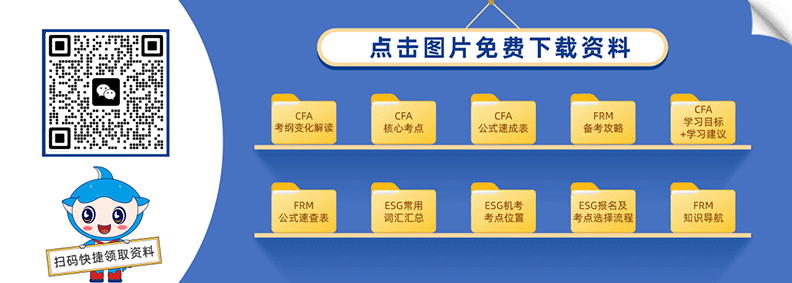2022年FRM二级的考纲整体不大,所有学科的考试占比维持不变。下文是详细介绍,送给备考的你,希望对你有所帮助!
从学科内容来看,Basel Accords,Liquidity Risk Management, Investment Risk Management这三个部分考点要求完全没有变化。》》》戳:各科视频讲义+历年真题+21年原版书(PDF版)免·费领取
Market Risk Management和Operational Risk Management做了小幅的修改,涉及修改的地方主要是描述性词汇的调整。
变化比较大的就是Credit Risk Management和Current Issue。其中Credit Risk Management一章的原版书参考发生变化,虽然内容比较类似,但是仍然需要根据zui新考纲进行学习。
Current Issue仍然结合热点来学习,去年的10篇文章中删除了9篇比较旧的文章,并新增加了和新冠疫情,数字货币,人工智能相关的zui新研究文章。
Market risk考点对比 :
市场风险这门课占比仍保持20%,2022年考纲中调整的部分为描述性词汇的调整,内容上并没有实质性改变。整体来看,今年的考纲变化对本科目的备考没有影响。
修改的LOS:(共4条)
Chapter 3. Estimating Market Risk Measures:
Define coherent risk measures. (2021)
Describe coherent risk measures. (2022)
Chapter 6. Backtesting VaR:
Define and identify Type I and Type II errors. (2021)
Identify and describe Type I and Type II errors in the context of a backtesting process. (2022)
Chapter 11. VaR Mapping:
Explain how VaR can be used as a performance benchmark(2021)
Explain how VaR can be computed and used relative to a performance benchmark. (2022)
Chapter 20. Volatility Smiles:
Define volatility smile and volatility skew(2021)
Describe a volatility smile and volatility skew(2022)
Credit Risk考点变化:
从调整上看,可以认为2022年的考纲几乎没有变化。有一个Reading因为参考书更新了版本,因此相应的章节有更新,但知识点没有调整。同时,资产证券化这一个章节引入了一个新的考纲要求,属于小知识点,涉及内容较少。剩余调整如章节的合并,对复习备考没有实质影响。
1. 教材变化
知识点结构没变,但原参考书更新了版本
Chapter 9. Counterparty risk and beyond
考纲要求描述改变,但实质知识点没变
Chapter 11. Future value and exposure
2022年要求: Explain the general impact of aggregation on exposure, and the impact of aggregation on exposure when there is correlation between transaction values.
2021年要求: Explain the impact of netting on exposure, the benefit of correlation, and calculate the netting factor.
2. 原版书结构调整,实质知识点没变
2022年将21年旧考纲中的Reading 14 Credit and Debt value adjustment以及Reading 15 Wrong way risk合并,形成2022年的Reading 13 CVA。
3. 新增考纲要求
2022年Reading 17 an introduction to securitization新引入考纲要求
Determine the notional value of the net contract resulting from trade compression and identify the counterparty with the net contract.
Operational risk:考点对比
总体来看,2022年操作风险的考纲有些许变化,主要变动在于操作弹性。对这个话题进行了更新和内容上的扩充。可见,协会越来越注重对于弹性这个领域的探讨和研究,这个话题无疑将成为日后这门学科的新重点。不过,这些内容上的调整对于学员备考没有太大的影响。
新增:
Chapter 25: Operational resilience: Impact tolerance for important business services
• Describe an impact tolerance; explain best practices and potential benefits for establishing the impact tolerance for a business service.
• Provide examples of important business services and explain criteria that firms should use to determine their important business services.
• Explain tools and processes, including mapping and scenario testing, that
financial institutions should use to improve their operational resilience and
remain within their impact tolerance.
• Describe the governance of an operational resilience policy, including the relationships between operational resilience and a firm’s risk appetite, impact tolerance, continuity planning, and outsourcing to third-party providers.
这个章节更新了表述,主要内容未发生实质性变化,依然以定性为主。探讨了在操作弹性领域的实践和指导方针这个主题在全球金融机构中变得越来越重要。
Chapter 26: Principles for Operational Resilience
• Define and describe operational resilience and explain essential elements of operational resilience.
• Explain recommended principles that banks should follow to implement an effective operational resilience approach.
这一章节是上一章节的延续,继续讨论操作弹性,阐述巴塞尔委员会对于操作弹性提出的一系列原则,可见弹性这个话题将越来越值得关注。
调整:
Chapter 5: Banking Conduct and Culture
2021:
• Explain how a bank can structure performance incentives and make staff development decisions to encourage a strong corporate culture.
• Summarize expectations by different national regulators for banks’ conduct and culture.
2022:
• Assess the role of regulators in encouraging strong conduct and culture at banks, and provide examples of regulatory initiatives in this area.
删减:
Chapter 4: Implementing Robust Risk Appetite Frameworks to Strengthen Financial Institutions
• Explain the relationship between a firm’s RAF and its risk culture and between the RAF and a firm’s strategy and business planning process.
Current Issues考点变化
今年Current issues从去年的10篇文章减少到了今年的8篇文章。大部分内容都是新加入的。
今年7篇新的文章中,有2篇是和新冠疫情的大背景相关,2篇是和人工智能等新兴科技相关的,1篇气候变化,1篇参考利率,1篇数字货币。除数字化货币外,其它的文章都在过往有过讲解,这次是用新的视角重新解读。随着数字货币在全球的越来越流行,这一趋势引起了行业的重视,非 常与时俱进。
删除
去年的10篇文章中,删除了9篇,只保留了Beyond LIBOR: a primer on the new benchmark rates。
新加入以下文章
1. Machine Learning and AI for Risk Management
这篇文章讲解了Machine Learning 和 AI的区别,以及每个类别中使用的技术。Machine Learning 和 AI在信用风险、市场风险、操作风险和监管合规等领域的应用。zui后在风险管理中Machine Learning 和 AI的作用以及局限性和挑战。
2. Artificial Intelligence Risk & Governance
这篇文章讲解了金融公司使用人工智能相关的潜在风险类别,人工智能治理的四个核心组成部分以及与每个组成部分相关的推荐做法,金融公司使用人工智能会如何产生与可解释性和歧视相关的问题,以及金融公司可以用来降低人工智能风险的做法。
3. Covid-19 and cyber risk in the financial sector
这篇文章讲解了cyber risk的原因和实施网络攻击的方法。以及COVID-19 对网络威胁级别的影响。大流行期间金融部门如何受到cyber risk的威胁。cyber risk格局的变化以及减轻风险以稳定金融系统的方法。
4. Holistic Review of the March Market Turmoil
本章主要展示了2020 年 3 月 Covid-19 市场动荡期间发生的金融市场情况和大流行对金融市场的影响,及其这期间市场压力的原因。公共部门在 Covid-19 市场动荡期间恢复金融市场运作的政策反应,以及我们应该从中吸取的教训。
5.LIBOR transition Case studies for navigating conduct risks
本章讨论了对 LIBOR 过渡的监管预期以及这些预期如何帮助市场参与者管理过渡产生的行为风险。以及从卖方和买方的角度分析 LIBOR 过渡的风险。
6.Climate-related risk drivers and their transmission channels
本章讲解了与气候相关的风险驱动因素和潜在影响以及如何给银行带来不同类型的风险。
7.The rise of digital money
本章讲解了支付方式的不同属性。数字货币快速发展的原因和对银行业面临的风险并确定减轻这些风险的方法,以及对应的监管和政策行动。
想要了解更多有关FRM考试相关的内容,可以在线咨询或添加融跃老师微信(15378732641)!
- 报考条件
- 报名时间
- 报名费用
- 考试科目
- 考试时间
-
GARP对于FRM报考条件的规定:
What qualifications do I need to register for the FRM Program?
There are no educational or professional prerequisites needed toregister.
翻译为:报名FRM考试没有任何学历或专业的先决条件。
可以理解为,报名FRM考试没有任何的学历和专业的要求,只要是你想考,都可以报名的。查看完整内容 -
2024年5月FRM考试报名时间为:
早鸟价报名阶段:2023年12月1日-2024年1月31日。
标准价报名阶段:2024年2月1日-2024年3月31日。2024年8月FRM考试报名时间为:
早鸟价报名阶段:2024年3月1日-2024年4月30日。
标准价报名阶段:2024年5月1日-2024年6月30日。2024年11月FRM考试报名时间为:
早鸟价报名时间:2024年5月1日-2024年7月31日。
标准价报名时间:2024年8月1日-2024年9月30日。查看完整内容 -
2023年GARP协会对FRM的各级考试报名的费用作出了修改:将原先早报阶段考试费从$550上涨至$600,标准阶段考试费从$750上涨至$800。费用分为:
注册费:$ 400 USD;
考试费:$ 600 USD(第一阶段)or $ 800 USD(第二阶段);
场地费:$ 40 USD(大陆考生每次参加FRM考试都需缴纳场地费);
数据费:$ 10 USD(只收取一次);
首次注册的考生费用为(注册费 + 考试费 + 场地费 + 数据费)= $1050 or $1250 USD。
非首次注册的考生费用为(考试费 + 场地费) = $640 or $840 USD。查看完整内容 -
FRM考试共两级,FRM一级四门科目,FRM二级六门科目;具体科目及占比如下:
FRM一级(共四门科目)
1、Foundations of Risk Management风险管理基础(大约占20%)
2、Quantitative Analysis数量分析(大约占20%)
3、Valuation and Risk Models估值与风险建模(大约占30%)
4、Financial Markets and Products金融市场与金融产品(大约占30%)
FRM二级(共六门科目)
1、Market Risk Measurement and Management市场风险管理与测量(大约占20%)
2、Credit Risk Measurement and Management信用风险管理与测量(大约占20%)
3、Operational and Integrated Risk Management操作及综合风险管理(大约占20%)
4、Liquidity and Treasury Risk Measurement and Management 流动性风险管理(大约占15%)
5、Risk Management and Investment Management投资风险管理(大约占15%)
6、Current Issues in Financial Markets金融市场前沿话题(大约占10%)查看完整内容 -
2024年FRM考试时间安排如下:
FRM一级考试:
2024年5月4日-5月17日;
2024年8月3日(周六)上午;
2024年11月2日-11月15日。FRM二级考试:
2024年5月18日-5月24日;
2024年8月3月(周六)下午;
2024年11月16日-11月22日。查看完整内容
-
中文名
金融风险管理师
-
持证人数
25000(中国)
-
外文名
FRM(Financial Risk Manager)
-
考试等级
FRM考试共分为两级考试
-
考试时间
5月、8月、11月
-
报名时间
5月考试(12月1日-3月31日)
8月考试(3月1日-6月30日)
11月考试(5月1日-9月30日)








